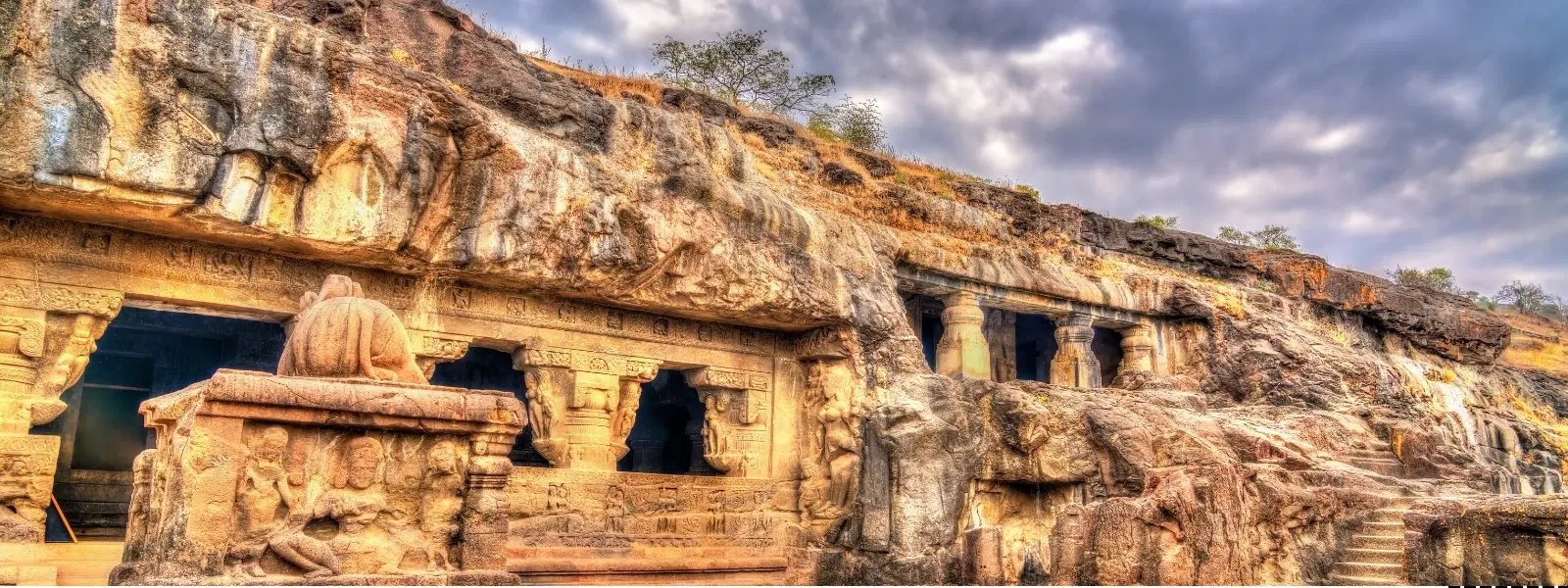
Flights
•04 min read

The ancient temples carved in mountains are breathtaking wonders where nature meets human genius. These sacred sites, nestled into sheer rock faces and towering cliffs, are testaments to ancient craftsmanship and devotion. In this blog, we explore a checklist of 10 must-see temples carved in mountains that will inspire travel enthusiasts and history buffs alike, revealing the rich history, intricate architecture, and deep cultural significance behind these stone-carved shrines.
Temples carved in mountains captivate visitors with their seamless integration with natural landscapes. Their monolithic construction techniques, which involve carving directly into the rock, create awe-inspiring scenes where art and nature coexist. Across diverse civilizations, these sites have been imbued with spiritual meaning, serving as places of worship and meditation while also standing as symbols of an era's architectural prowess.
Rock-cut architecture evolved from humble cave shrines into elaborate temple complexes that showcase the evolution of human creativity. Notable ancient rock-cut temples appear in India, Ethiopia, and Jordan. Their construction methods, which demanded precision and immense labor, continue to intrigue architects and historians alike. These digital relics remind us that cultural heritage is often hidden within the very bedrock of history.
Carved during the reign of the Rashtrakuta dynasty, the Kailasa Temple is a marvel of monolithic temple architecture. Known for its colossal scale and intricate carvings, this temple stands as one of the most celebrated examples of ancient rock-cut temples. Its sheer construction from a single rock block defies conventional building techniques, offering a unique peek into India's rich historical tapestry.
Famed as a UNESCO World Heritage Site, Petra was once a thriving trade hub. Its Treasury, with its iconic façade sculpted into rose-red cliffs, epitomizes the fusion of natural beauty and human ingenuity. Standing amidst sandstone canyons, Petra remains a symbol of an ancient civilization that mastered the art of creating temples in cliffs.
Deeply rooted in Buddhist heritage, the Ajanta Caves display exquisite murals and statues that blend harmoniously with their cliffside environs. Carved into the mountain over centuries, these artistic expressions represent the creative zenith of ancient artisans and continue to inspire a spiritual pursuit in every visitor.
In Lalibela, Ethiopia, rock-hewn churches were meticulously chiseled from solid rock. These sanctuaries hold great religious importance and are cherished pilgrimage sites that showcase the distinct architectural styles and spiritual symbolism of their era.

The Longmen Grottoes are home to hundreds of Buddhist carvings and statues, gracefully adorning the steep cliffs. These sacred rock formations are significant not only for their artistic merit but also as spiritual beacons that have guided devotees for centuries.
Beyond these celebrated sites, there are several other temples carved in mountains that deserve attention. The Elephanta Caves in India, Lycian Tombs in Turkey, and Cliff Palace in the USA each offer distinct historical narratives and show how different cultures have embraced the idea of etched mountain sanctuaries.
Monolithic temple structures are a remarkable feat where entire temples are carved out of a single rock. Kailasa Temple stands as a prime example, where precision and vast human effort culminated in a temple that continues to astound architects and tourists alike due to its coherent, all-in-one structure.
The natural formation of rock often plays a decisive role in the layout and symbolism of these places. In many Hindu traditions, temples are shaped like mountains to symbolize Mount Meru, the axis of the universe. Such sacred rock formations reflect a deep spiritual connection to nature and the heavens.
One of the most enchanting aspects of mountain-carved temples is their integration with the surrounding environment. The way these ancient rock-hewn religious sites harmonize with nature creates a serene and immersive atmosphere. The interplay of sunlight on weathered stone and the natural acoustics of wind in the crevices enhance the mystical experience, making them perfect retreats for both introspection and exploration.
Visiting these historic mountain carvings can be magical when timed with nature’s rhythm. For many locations, spring and autumn offer pleasant weather and vibrant colors, enriching the overall experience. Additionally, aligning your visit with local festivals or cultural events can provide deeper insight into the spiritual traditions associated with these sites.

Planning a visit to these remote temples requires careful thought. Consider the terrain, weather, and necessary gear for exploring mountainous landscapes. Research local transportation options and nearby accommodations that complement the natural setting without disrupting its tranquility. For instance, arranging flexible travel itineraries can make the journey as enriching as the destination itself.
When visiting these historic mountain carvings, it is essential to respect local customs and traditions. Tailor your behavior to honor the spiritual and cultural significance of these sites, ensuring their preservation for future generations. In every interaction, act as a gracious guest in a place that resonates with centuries of devotion and history.
Did you know? The Kailasa Temple at Ellora was carved out of a single rock, and its construction remains a mystery to historians due to its sheer scale and precision.
The Kailasa Temple at Ellora is one of the most famous examples of a temple carved into a mountain.
Such temples can be found worldwide, including Petra in Jordan, the Ajanta Caves in India, and the Rock-Hewn Churches of Lalibela in Ethiopia.
Hindu temples often symbolize Mount Meru, considered the axis of the universe, representing a spiritual connection between heaven and earth.
The Kailasa Temple at Ellora and the Ajanta Caves are prominent examples of rock-built temples in India.
Mountain-carved temples are not only architectural marvels but also profound symbols of cultural and spiritual heritage. Their ability to harmonize with nature and withstand the passage of time continues to inspire awe and curiosity. These sacred rock formations remind us of human ingenuity and devotion that transcends the ordinary, inviting travelers to embark on journeys filled with wonder and discovery.